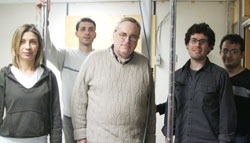Heat transfer measured in Hydro-Quebec lab

The team who worked on the heat-transfer experiments in Shawinigan in December. Left to right, PhD candidate Panagiota Karava, postdoctoral fellow Thanos Tzempelikos, Louis Handfield, project leader at LTE (Hydro-Quebec), master’s student Mark Bessoudo and doctoral candidate Luis Candanedo.
Courtesy Thanos Tzempelikos
One of the objectives of the Solar Buildings Research Network’s (SBRN) many projects is to study thermal comfort, heat transfer and airflow near windows and facades with different heating configurations.
In December, a team of four Concordia University researchers and graduate students visited the Laboratoire des Technologies de l’Energie (LTE), a Hydro-Quebec research facility in Shawinigan, to conduct detailed experiments on heat and airflow transfer in a thermally controlled perimeter space.
Postdoctoral fellow Thanos Tzempelikos explained that the LTE facilities include a test chamber with a glass facade that separates a cold room from a warm room. Conditions in both rooms can be perfectly controlled.
“The warm room is equipped with three types of heating systems: baseboard heaters, radiant ceiling panels and heated windows. It is usually kept at standard room temperture. The temperature of the cold room can reach -180C. The windows are also equipped with standard commercial roller shades.
“The objective of the experiments was to examine how air and heat are transferred near the windows using different heating configurations with and without shading devices, as well as the impact of the above on thermal comfort.”
Concordia’s energy laboratory, managed by the head of the SBRN, Professor Andreas Athienitis, is equipped with state-of-the-art equipment for detailed automatic airflow measurements. The Particle Image Velocimeter (PIV) consists of a laser unit and a special camera that captures microscopic movements of particles illuminated by a laser sheet within microseconds.
Tzempelikos said the PIV was key to the tests in Shawinigan. “It is the best and most accurate instrument for airflow measurements, and very few people have it except for Athienitis. This is why Hydro-Quebec asked us to do the experiments in their facilities with our equipment.”
The instrument was placed on a new automatic 2D motorized traverse system which allows the measurement plane to move up and down as well as closer to or further away from the facade. The movement permits maximum coverage of the area for airflow measurements.
“A large number of thermocouples were placed at different heights and distances from the windows as well as on the traverse system for simultaneous temperature measurements.”
The Concordia team was equipped with a new data acquisition system and laptops for measuring data in real time, as well as temperature sensors and an infrared camera for thermal measurements. In the four full days of experiments a number of different cases were studied.
“Airflow and thermal measurements were taken along the entire window surface in order to examine the flow patterns closer to and further from the heating source,” Tzempelikos said.
“Every surface in the room was equipped with tens of thermocouples which were also suspended in the air at different heights and positions. Results were recorded during each measurement together with the electrical output of the heating sources.”
The resulting airflow patterns and thermal conditions — near cold and warm windows, with and without heating sources and shading devices — will be used to predict the energy performance of perimeter rooms and building facades from the design stage in order to reduce energy consumption, improve thermal comfort and reduce the capital costs of heating buildings.
The results of the experiments are currently being processed, and will be published for the next Solar Buildings Conference in June 2007.